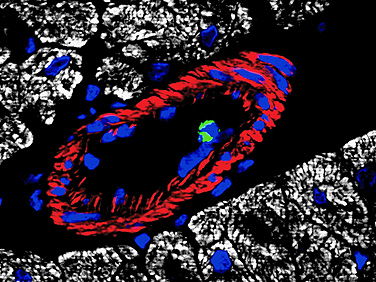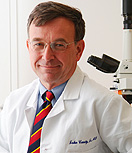News
New heart cells grow by 30 percent
after stem-cell infusion, UB research shows

Blood vessel showing a circulating bone marrow-derived stem cell (green) adherent to the vessel wall.
-
 Print
Print -
 Comments
Comments
-

“The rationale for our approach is somewhat analogous to planting seeds in fertile soil versus trying to grow plants in sand.”
New, healthy heart cells have been generated by animals with chronic ischemic heart disease after receiving stem cells derived from cardiac biopsies, or “cardiospheres,” according to research conducted at the School of Medicine and Biomedical Sciences and presented earlier this week at the American Heart Association’s annual meeting in Orlando.
The UB research demonstrated a 30-percent increase in healthy heart-muscle cells within a month after receiving cardiosphere-derived cells (or CDCs). This finding is contrary to conventional wisdom that has held that heart cells are terminally differentiated and, thus, unable to divide.
Ischemic heart disease from coronary-artery narrowing and prior heart attacks is the most common cause of heart failure, the UB researchers explain. While other investigators have focused largely on regenerating muscle in scarred tissue, the UB group has shown that cardiac repair could be brought about by infusing the CDCs slowly into coronary arteries of the diseased as well as normal areas of the heart.
“Whereas most research has focused upon irreversible damage and scarring following a heart attack, we have shown that a single CDC infusion is capable of improving heart function in areas of the heart that are viable but not functioning normally,” says study co-author John M. Canty Jr., Albert and Elizabeth Rekate Professor of Medicine in the UB medical school and UB’s chief of cardiovascular medicine.
Canty explains that areas of myocardial dysfunction without fibrotic scarring are common in patients with heart failure from coronary artery disease and that they arise from remodeling in response to a heart attack, as well as adaptations that develop from periods of inadequate blood flow, sometimes called hibernating myocardium.
“The rationale for our approach is somewhat analogous to planting seeds in fertile soil versus trying to grow plants in sand,” Canty notes.
“We have shown that cells derived from heart biopsies can be expanded outside of the body and slowly infused back into the coronary arteries of animals with chronic dysfunction from restricted blood flow or hibernating myocardium,” says Gen Suzuki, research assistant professor of medicine in the UB medical school and lead author on the research. “The new cardiac muscle cells are small and function more normally than diseased, large, hypertrophied myocytes.”
Canty adds that infusing stem-cell formulations directly into coronary arteries also delivers the cells throughout the heart and is much simpler than injecting cells directly into heart muscle, which requires equipment that is not widely available.
The research currently is in a preclinical phase, but the UB researchers expect that translation to determine effectiveness in patients could take place within two to three years, or possibly even sooner.
Co-authors on the paper are Thomas Cimato, assistant professor of medicine and Merced Leiker, research associate in the UB Division of Cardiovascular Medicine.
The research was funded by the Department of Veterans Affairs; the Empire State Stem Cell Board; the National Heart, Lung and Blood Institute of the National Institutes of Health; and the Albert and Elizabeth Rekate Fund.

Reader Comments